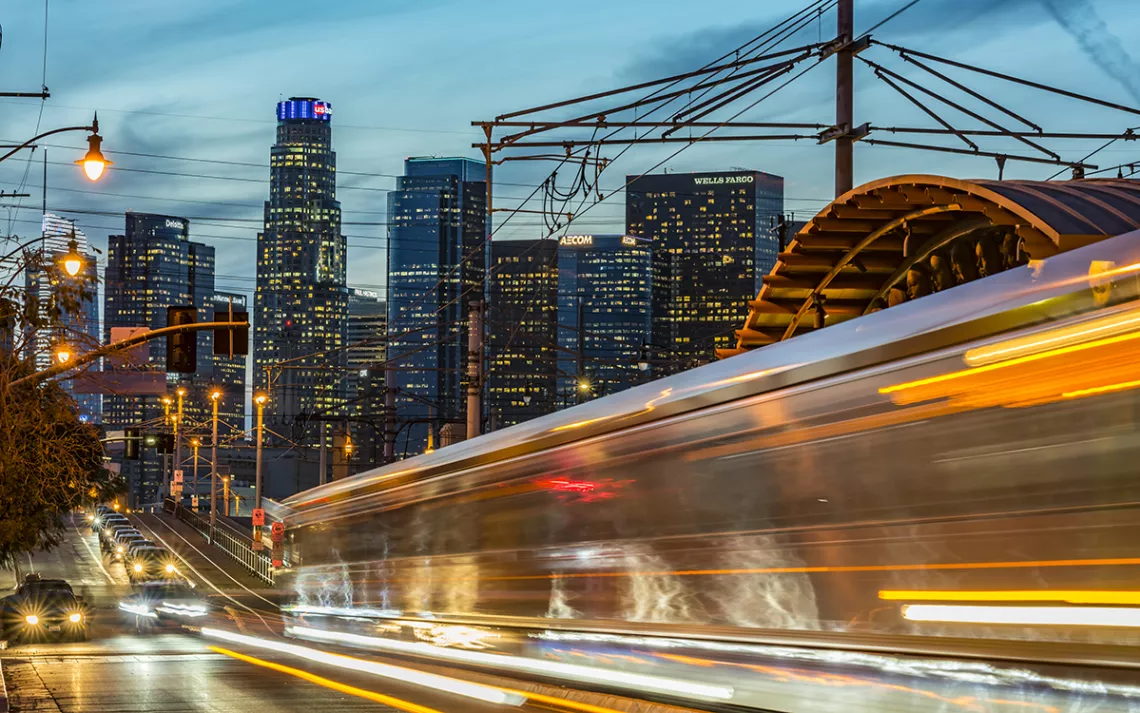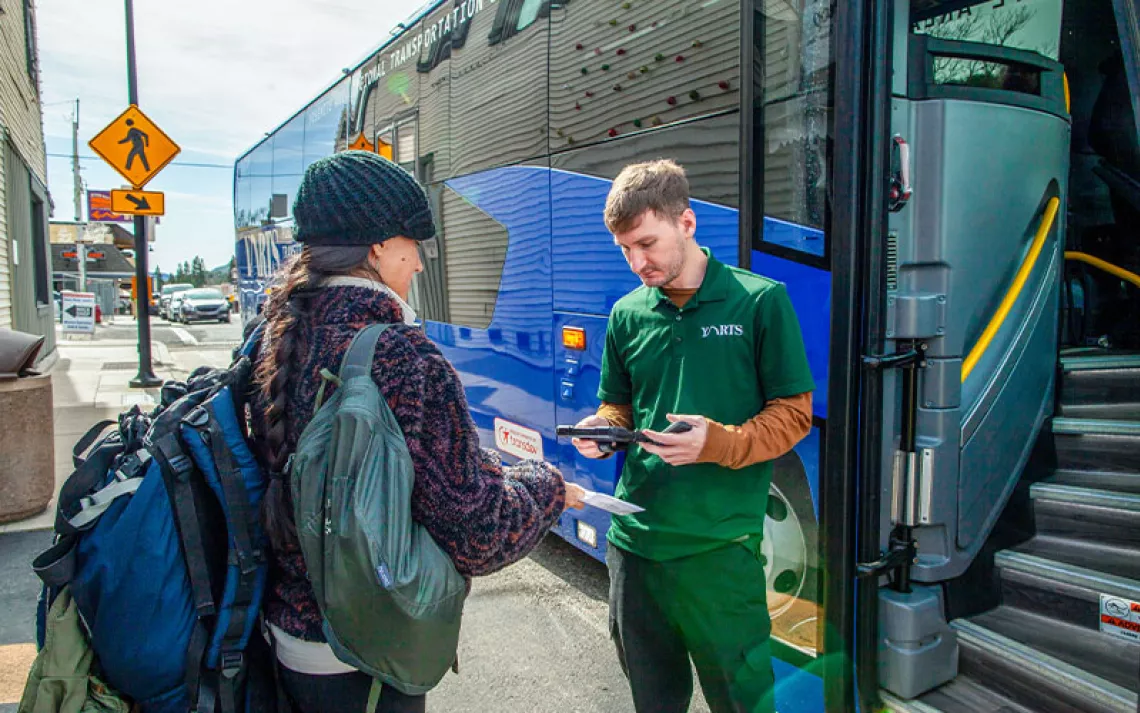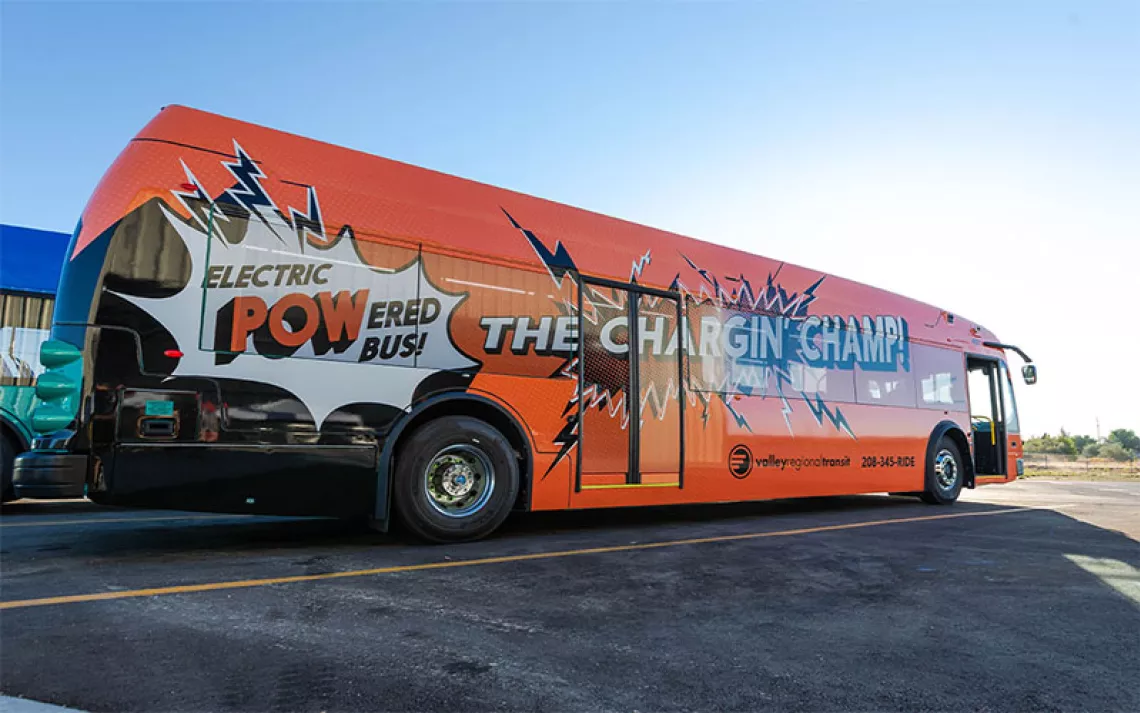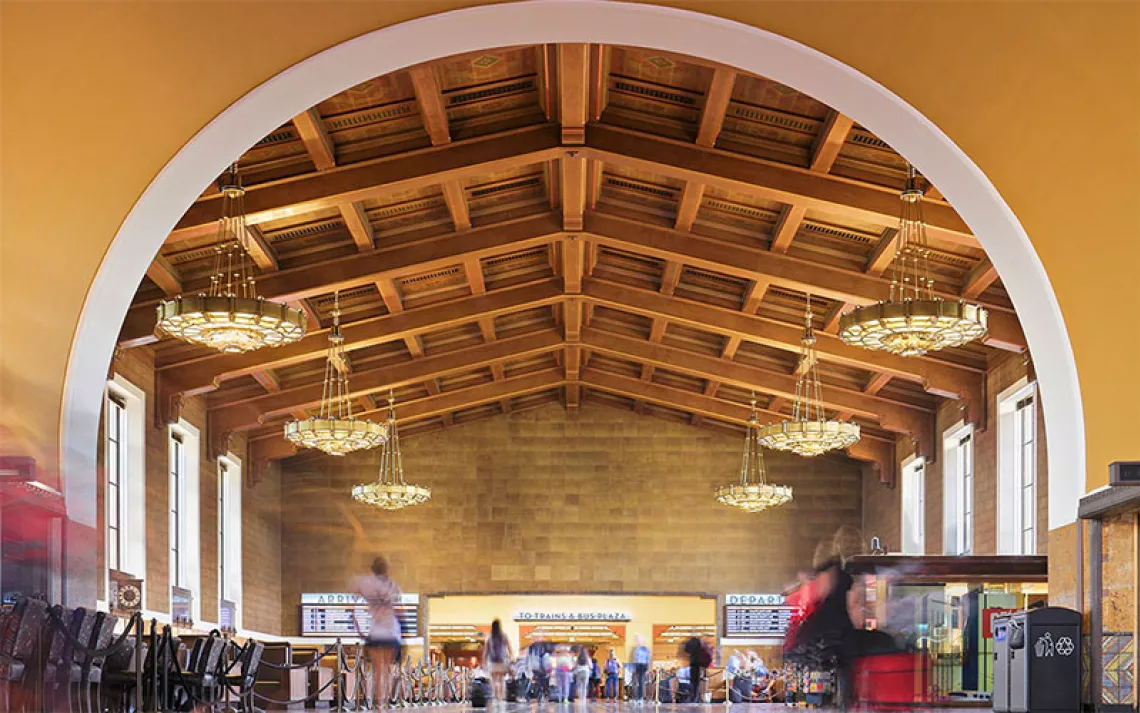L.A.'s Transit Ridership Is Plummeting
Why is the City of Angels still struggling to shake off its smoggy image?

Photo by 4kodiak/iStock
In the 1920s, Los Angeles fell in love with cars. Now, almost a century later, the city is trying to end the affair.
Facing the worst congestion in the nation, notoriously bad air quality, and of course, climate change, L.A. is pouring billions into expanding its public transit system. But despite the completion of several expensive new rail projects, transit ridership is plummeting. Boardings for Southern California’s largest transit carrier, the Los Angeles County Metropolitan Transit Authority (Metro), dropped around 17 percent in the past five years—from just under 473 million in 2013 to around 391 million in 2018.
The decline in public transit ridership comes at a time when L.A. is trying to shake off its smoggy image and rebrand itself as a sustainable megacity. Its sustainability plan, L.A.’s Green New Deal, takes aim at car culture, calling for both a 13 percent reduction in Vehicle Miles Traveled (VMT) per capita and a 35 percent increase in trips made by transit, walking, biking, or micro-mobility by 2025.
Voters have signaled their willingness to invest in transit improvements by approving four sales tax increases for transportation projects: Prop A in 1980, Prop C in 1990, Measure R in 2008, and Measure M in 2016.
Why, then, aren’t more Angelenos using the public transit system they are funding?
Transit spending has a controversial history in Los Angeles. To understand it―and to discern whether or not L.A. Metro is repeating past mistakes―you have to go back to the 1980s, when Angelenos decided that the city’s all-bus transit fleet wasn’t cutting it. L.A. wanted rail. Once upon a time, decades earlier, hundreds of miles of rail had woven through L.A., but over the course of decades, those streetcar routes were torn up and replaced by less expensive, more flexible bus service.
The vision for a city connected by light and heavy rail took a major step forward in 1980 when voters approved Prop A, the first of four half-cent sales tax increases, to fund public new rail projects and bus improvements.
Initially, the Southern California Rapid Transit District received around 20 percent of Prop A funds for a subsidized bus fare program; between 1982 and 1985, bus fares were reduced from 85 cents to 50 cents, and monthly passes were reduced to $20 for the basic transit pass and $4 for the elderly, people with disabilities, and students. In response to the fare reductions, ridership numbers soared, increasing 40 percent from just over 354 million annual boardings in 1982 to just over 497 million annual boardings in 1985.
Then in 1986, the Los Angeles County Transportation Commission cut funding for the subsidized bus fare program and shifted money to light and heavy rail construction projects. Between 1986 and 1989, bus fares increased from 85 cents a ride to $1.10. Ridership immediately declined, dropping 8 percent to around 411 million annual boardings in 1989.
“If we look at periods when public transit ridership has increased, and periods when it has decreased, I don’t think it is hard to figure out what is driving the change,” James Moore, II, director of the Transportation Engineering Program at USC, said. “[Transit riders] are a very price-sensitive group. When you raise fairs, you price them off the system.”
Watching bus fares skyrocket and service decline, bus riders grew indignant. Angelenos were tired of watching from the curbside as buses cruised by their stops, unable to accommodate more passengers. In order to resist fare increases and service cuts, community organizers formed the Bus Riders Union (BRU) in 1992. The BRU galvanized its supporters around opposition to an adversary―the Metropolitan Transit Authority (MTA, now L.A. Metro). According to the BRU, MTA was building out its rail system by cannibalizing its bus system, which serviced mostly low-income people of color. L.A.’s rail system, the BRU argued, connected to the wealthier, whiter suburbs.
Tensions between bus riders and the MTA reached an all-time high when MTA passed a fare increase that included the elimination of monthly passes. In 1994, a coalition of groups representing bus riders, including the BRU and the NAACP, filed a class-action lawsuit against MTA, accusing the agency of transit racism. By disproportionately funding rail projects, the plaintiffs argued, MTA was favoring white suburbanite riders over poor people of color, violating the Civil Rights Act of 1964.
The court delivered the BRU and allies an impressive legal victory in 1996; the resulting 10-year consent decree mandated that MTA purchase new buses to reduce overcrowding and reduce the cost of a monthly pass to $42.
During the period when MTA was bound by the consent decree, transit ridership in L.A. increased significantly, rising from around 363 million passenger trips in 1996 to just over 495 million passenger trips in 2007. In 2008, shortly after the consent decree expired, ridership numbers started to drop off. Transit ridership has been declining consistently since 2014. (Note that all ridership statistics in this story were calculated based on the fiscal year. According to the calendar year, the consistent decline in transit ridership started in 2013.)
Did court-mandated investment in bus service drive higher transit numbers while it was in place? And how did the end of the consent decree affect ridership? Transportation experts disagree.
Moore, who provided key assistance to the BRU during its legal battle with MTA, argues that the consent decree played a key role in expanding ridership while it was in place. “When Metro was no longer bound by the settlement, it refocused its efforts almost exclusively on new rail projects,” Moore wrote in a 2017 Los Angeles Times opinion piece, coauthored by Thomas A. Rubin, the former chief financial officer of the Southern California Rapid Transit District. “The quality of bus service began declining in almost every way measurable, and overall ridership again fell.”
Michael Manville, associate professor of urban planning at UCLA and author of a 2018 report on falling transit ridership in Southern California, does not see a correlation between the end of the consent decree and the subsequent decrease in transit ridership. In fact, Manville’s report refutes a key aspect of Moore’s argument―that high transit prices, which the consent decree kept down, were a key factor driving down transit ridership over the course of the last decade.
“The evidence that we see is that fares don’t seem to have a huge influence [on transit ridership], but they don’t move that much either, in real terms,” Manville said. Manville’s report, which focuses on ridership since the year 2000, finds that “changes in transit service and fares have mostly followed and not led falling ridership.”
Manville’s report, however, focuses on six counties in Southern California―Los Angeles, Orange, Riverside, San Bernardino, Ventura, and Imperial. Looking at broad trends in the region, as the report acknowledges, can “mask significant variation among transit operators.”
What, if not transit prices, is causing ridership numbers to fall?
According to Manville’s report, higher rates of car ownership―especially among low-income, immigrant Angelenos who traditionally make up transit’s core ridership―is the single most important factor driving down public transit use in Southern California. The report did not look at whether a disparity in financial investment between rail and bus service could be a factor.
Over the past few decades, improvements to bus service, like the addition of bus rapid transit lanes, which can dramatically improve commute times, have taken a back seat to L.A. Metro’s billion-dollar rail projects, despite the relative cost-effectiveness of bus projects.
Perversely, the high price tag on rail projects is one reason rail has taken priority, according to Juan Matute, deputy director of the Institute of Transportation Studies at UCLA. Members of Metro’s Board of Directors―13 members representing areas across L.A. County―have a political incentive to deliver contracts to their constituencies. Those political interests do not always align with the real needs of transit riders.
“One of the most powerful forces in Metro’s investment program [is] the idea of geographic equity . . . trying to spread the money around L.A. County, regardless of the cost-effectiveness or the need for the project,” Matute said. “That is a political decision, given how county district representation on the Metro board is set up.”
Given L.A. Metro’s prioritization of rail projects, is the transit agency making the same mistakes that preceded the consent decree? Again, experts disagree.
“If they didn’t understand that they were going to lose riders, it would qualify as a mistake,” Moore said. “But they do understand. These are college-educated people. They know full well what they are doing, and they are abandoning their obligation to serve a low-income group in exchange for growing an agency and delivering rail projects to various groups of constituents.”
Manville isn’t convinced. “Are we at the type of situation that precipitated the [lawsuit] back then? I don’t think so,” he said. “I think Metro is now much more cognizant of that criticism.”
Back in the 1990s, a key aspect of BRU’s case against MTA was that L.A. rail riders were more likely to be higher income and white than bus riders. That is still true today―but both services overwhelmingly serve low-income riders. According to L.A. Metro data from 2018, the median household income of L.A. bus riders was $17,154, compared with a median household income of $32,634 for rail. Notably, 14 percent of rail riders had a household income above $100,000―compared with just 3 percent of bus riders.
Some transportation planners see rail as key to luring Angelenos with transportation alternatives out of their cars and onto transit lines. L.A. will certainly need to make a lot of progress in that area if it wants to achieve the goals outlined in its sustainability plan. Still, all that rail construction is an expensive strategy for enticing new transit riders, and to date, it hasn’t worked.
Moore acknowledges that one challenge facing L.A. Metro is that L.A. has given the agency inconsistent and competing objectives. “On the one hand, we say please serve low-income groups that otherwise would not be served, and in the same breath we say, oh, and by the way . . . configure a service that will attract [us] out of our cars. You can’t really do that following the same strategy.”
Implementing congestion pricing, or charging people a fee to drive on traffic-ridden roads, could give drivers the push they need to start taking transit―and make L.A.’s investment in rail make more sense.
“The rail system we are building in Los Angeles County makes sense if there is a comprehensive system of congestion pricing in the county,” Matute said. “The volumes of transit riders we would expect with that, the buses with bus-only lanes would need to have the capacity of a rail network, in order to make it work. But in absence of that, a lot of the . . . far-flung rail investment outside of the core, high-ridership corridors of the county, is much less justified.”
According to Moore, the solution to falling ridership is to lower transit fares and invest in bus service. “We could reverse this trend in ridership and increase it very quickly,” he said.
L.A. Metro argues that spending on rail is a long-term investment. Once L.A. has built out its rail network, then Angelenos will start riding transit again.
The climate implication of L.A.'s gamble on rail is important. Fewer transit riders means more cars on the streets―something L.A.'s climate goals can't afford.
 The Magazine of The Sierra Club
The Magazine of The Sierra Club



